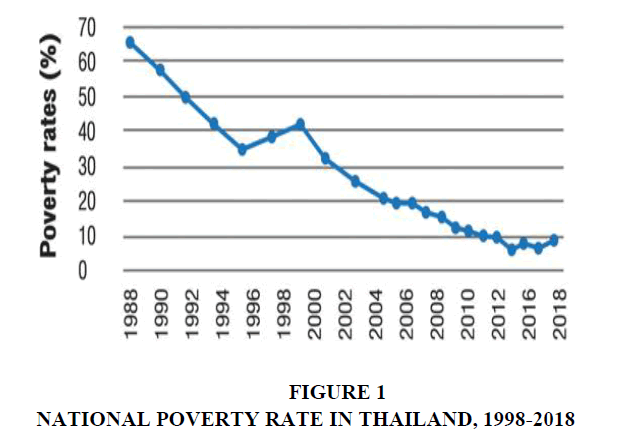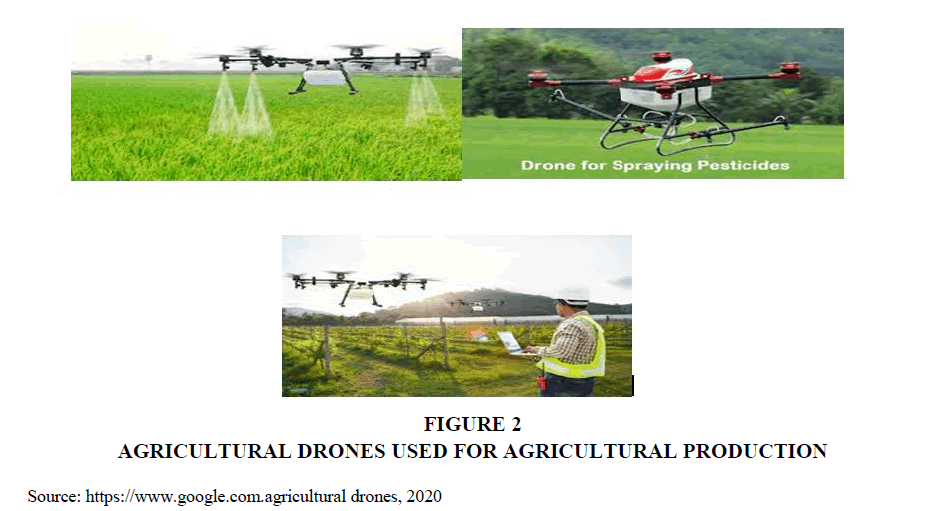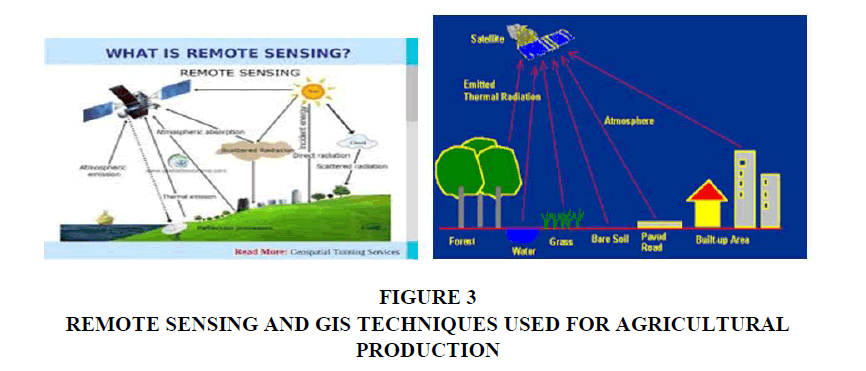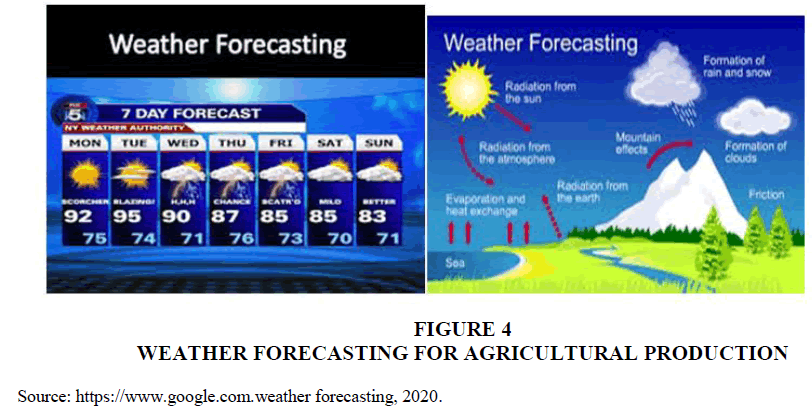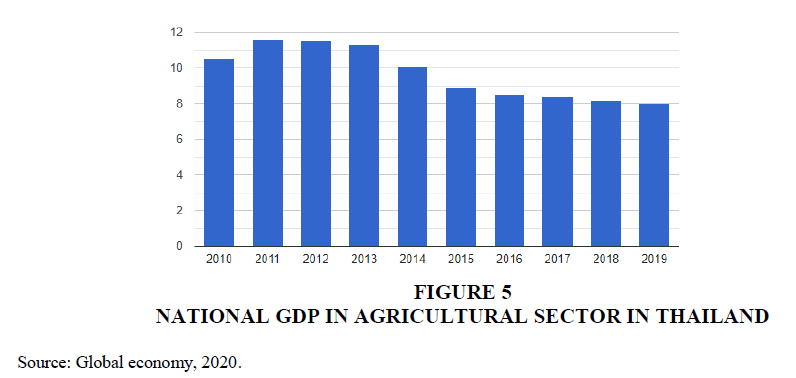Research Article: 2023 Vol: 26 Issue: 2S
A Current Scenario on Agriculture and Rural Poverty in Thailand
Ferdoushi Ahmed, Prince of Songkla University
M. S. Mia, Universiti Utara Malaysia
Paratta Prommee, Prince of Songkla University
Onanong Longphichai, Prince of Songkla University
Citation Information: Ahmed, F., Mia, M.S., Prommee, P., & Longphichai, O. (2023). A current scenario on agriculture and rural poverty in thailand. Journal of Management Information and Decision Sciences, 26(S2), 1-11.
Abstract
Agriculture is considered as one of the important economic sectors in Thailand. The present study focuses on the current scenario of agriculture in Thailand. The study also highlights the role of Thai agriculture in rural poverty reduction. This study extracted secondary data from various sources including the Department of Statistics, Thailand, Ministry of Agriculture, Thailand, the World Bank, Asian Development Bank (ADB), FAOSTAT, National Economic and Social Development Board (NESDB), and National Economic and Social Development Council (NESDC). The findings revealed that agricultural production in Thailand has improved considerably over the past 40 years. Rapid transformation and modernization in the agriculture sector in the last three decades were considered as the most important reason. Consequently, the contribution of agriculture to national GDP has increased gradually during the past few years. It was also found that Thai agriculture played an important role in reducing rural poverty in the country. The findings of the present study provides an insight about current scenario of Thai agriculture that might be useful for the policy makers to redesign the agricultural policies and plans so that agriculture sector can play a more significant role in reducing rural poverty in the country.
Keywords
Scenario, Agriculture, Rural Poverty, Thailand.
Introduction
Poverty is a complex and comprehensive phenomenon and covers many dimensions of human and social behavior. Poverty is a major problem around the world, and given its multi-dimensional nature, its conceptualization and measurement continue to be challenging. Therefore, poverty reduction has become the most important issue in the development policies of almost all the countries in the world. Poverty is mainly associated with lack of income and the individuals whose income level falls below the minimum level of human basic needs are considered as poor (World Bank, 2005). Setboonsarng et al. (2006) found that contract farming can be an effective institutional mechanism to reduce transaction costs faced by small-scale, poor rice farmers and hence increase profitability and reduce rural poverty. In their study there is significant profit inefficiency among the sample rice farmers in Thailand. Overall, rice farmers in Thailand could increase their profit by more than 30%.
Agriculture is vital to most ASEAN economies and provides livelihoods to a large segment of the population. In other words, agriculture has played and continues to play an important role in the ASEAN region. It is an important driver for social, inclusive growth; an important source of export earnings; a guarantor of food availability to its citizens; and a source of employment directly and through agriculture-related, value adding activities (Teng & McConville, 2016). In some ASEAN countries, agriculture employs over 60 per cent of the workforce and is an essential driver for growth and poverty alleviation. Moreover, ASEAN agriculture remains a powerhouse for the production and supply of important food items. It is home to two of the world’s largest rice exporting countries (Thailand and Vietnam) and the top three exporting countries for pineapples, bananas, mango, sugar crops, coffee, cashew nuts and cassava (Teng & McConville, 2016). In addition, ASEAN agriculture is the top producer and exporter of palm oil, coconut and rubber and a major producer and exporter of seafood. Recently, some ASEAN member countries have decided to focus more on “export-oriented” agriculture (for example, palm oil and rubber in Indonesia and Malaysia, high value beverages like cacao and coffee in Viet Nam) for their national development policies while others have recognized the importance of agriculture for both export and food security needs (e.g. Thailand and Vietnam) (Teng & McConville, 2016).
Hutaseranee & Jitsuchon (1988) asserted that poverty incidence in 1980/81 was better than in 1985/86, because of the effect of the extra high crop prices that year. This can be seen from the 4.6% decrease of the average income per capita of all agricultural workers between 1980/81 and 1985/86. This period of worsening poverty incidence was the first time since 1960 in which the average welfare of Thai people significantly deteriorated (Hutaseranee & Jitsuchon, 1988). Krongkaew & Tinakorn (1991) show that there was a lower percentage of rural Thais in poverty in almost every region. Except for Bangkok and the Central region, poverty incidence in municipal areas either increased or insignificantly decreased. They assert that this situation was similar to that in 19801/81. The major determinant of the reduction in 1988 poverty was crop prices which were at a peak among adjacent years. Despite that fact, this change had very significant consequences on changes in inequality. Moreover, Bergemeier & Hoffman (1988) studied the striking characteristic of poverty concentration in Thailand in 1981, pointing out that poverty incidence has a rural bias. Only 16.2% of urban residents were living in poverty, compared to 26.5% of rural residents. However, if Bangkok is excluded, the proportion of urban residents living in poverty rises to 25.7%, nearly the same as for rural areas. The wealth of Bangkok, and bordering subregions on the fertile central plains, is increasingly and sharply contrasted with average living standards, especially in the Northeastern and upper Northern regions (Center, 2017).
The Northeast not only has the largest rural sector, but also the poorest land quality in the country. About 38% of agricultural land in this region is salty, and only 8.64% is irrigated (Chuprakorb, 1989). Siamwalla et al. (1989) point out that the poor quality of land adversely affects the productivity of the agricultural labor force in the Northeast. Poverty is a problem of human capital. Hutaseranee & Jitsuchon (1988) found that in almost all poor families the household head did not have more than an elementary education. Thus, high poverty is expected among unskilled labor. Krongkaew & Tinakorn (1991) also found a very high poverty incidence among households whose heads were agriculturalists, laborers, or economically inactive people. The regional disparity in poverty reduction performance actually grew wider with the onset of the crisis. Between 1996 and 1999, the incidence of poverty increased sharply in the Northeast, somewhat in the South and Central regions, and declined in Bangkok and the North. Thus, by 1999, the poverty headcount in the Northeast was nearly two thirds of its 1988 level, while the corresponding ratio for Bangkok was a mere 3 percent. The North was somewhere in between, having a poverty headcount in 1999 that was one third of its 1988 level (Deolalikar, 2003).
Therefore, this study aims to focus on the current scenario of agriculture in Thailand. The study also highlights the contribution of agriculture in rural poverty reduction in the country (Chakrabarty, 2013).
Materials and Methods
This study was mainly based on retrospective secondary data for the last few years. Data were collected from the Department of Statistics and Ministry of Agriculture in Thailand. Other sources included the World Bank, Asian Development Bank (ADB), FAOSTAT, National Economic and Social Development Board (NESDB), and National Economic and Social Development Council (NESDC, 2019). Data were extracted from annual report, proceedings, and other related documents by searching comprehensively electronic and non-electronic databases. References cited in the literatures were searched and important studies were collected in full text. Descriptive statistics such as summation, average, percentage, ratio, maximum and minimum value were applied to analyze the data.
Findings and Discussions
Total population in Thailand
Table 1 shows the trend of total population in Thailand for the period of 2014-2019. The population of the country was estimated to be 65.12 million in 2014. However, the rate of population growth was very slow during the next five years. It can be seen that the total population of the country stood at 66.56 million in the year 2019. A number of factors contributed to lower population growth in Thailand during the last few years.
| Table 1 Total Population In Thailand, 2014- 2019 |
|
| Year | Population (Million) |
| 2014 | 65.12 |
| 2015 | 65.73 |
| 2016 | 65.93 |
| 2017 | 66.19 |
| 2018 | 66.41 |
| 2019 | 66.56 |
Source: National statistical office, 2020
Poverty in Thailand
Thailand has achieved a significant progress in poverty reduction during the past few decades. Nearly 57% of the total population of the country lived in poverty in 1960s. The country has been able to reduce poverty dramatically in the past 50 years. Reductions in poverty can also be seen across all regions of the country.
Figure 1 shows the poverty scenario in Thailand for the period of 1988 - 2018. It can be seen that poverty rate in the country followed a downward trend during the last three decades. The rate of national poverty in Thailand was found to be very high in the decade of 1980s (67% in 1988). However, there was a sharp decrease in poverty rate during the next eight years (33% in 1996). But the country experienced an increase in poverty over the following four years (40% in 2000). After that the national poverty rate in Thailand decreased gradually though there were ups and downs in poverty figure. It can be seen that poverty rate is significantly decreased about 10% in 2018.
Table 2 shows the poverty scenario in Thailand by region during 2014- 2018. It can be seen that among the five regions, Bangkok experienced the lowest incidence of poverty during the last five years. The rate of poverty in the Bangkok was 11.9% in 2014. However, the incidence of poverty in the Bangkok was found to be increased slightly during the last five years (12.4% in 2018). The data show that the Central region is the greatest poverty-prone area in the country. The rate of poverty in the region was estimated to be 28.6% in 2014. The region also experienced a slight increase in poverty incidence during the last five years (29.1% in 2018).
| Table 2 Poverty Rate (%) In Thailand By Region, 2014-2018 |
|||||
|---|---|---|---|---|---|
| Region | 2014 | 2015 | 2016 | 2017 | 2018 |
| Bangkok | 11.9 | 13.2 | 12.4 | 12.5 | 12.4 |
| Central | 28.6 | 28.1 | 28.6 | 28.9 | 29.1 |
| Northern | 17.5 | 17 | 17.2 | 17 | 17 |
| Northeastern | 28.4 | 28.4 | 28.2 | 27.9 | 27.6 |
| South | 13.5 | 13.3 | 13.5 | 13.8 | 14 |
The rate of poverty in Northern areas of the country was 17.5% in 2014. The rate of poverty in the region followed an almost similar pattern for the next five years (17.0% in 2017 and 2018). The Northeastern region is another biggest poverty-hit area in the country. Nearly 28.4% of the total population in the region lived in poverty in 2014. However, the region observed a gradual decrease in poverty incidence over the next four years (27.6% in 2018). Finally, the rate of poverty in the South region was found to be 13.5% in the year of 2014. The incidence of poverty in the region remained almost similar in fast five years though there were ups and downs in poverty figure.
The regional disparity in poverty reduction performance actually grew wider with the onset of the crisis. Between 1996 and 1999, the incidence of poverty increased sharply in the Northeast, somewhat in the South and Central regions, and declined in Bangkok and the North. Thus, by 1999, the poverty headcount in the Northeast was nearly two thirds of its 1988 level, while the corresponding ratio for Bangkok was a mere 3 percent. The North was somewhere in between, having a poverty headcount in 1999 that was one third of its 1988 level (Deolalikar, 2003).
Agriculture in Thailand – An Overview
The agricultural sector of Thailand has been called the “backbone” of the country. It is the most important sector for socio-economic development in the country. It generates food and protein for most of the Thai people. Agriculture sector still remains the largest source of employment to Thai population. About 64% of the total population in the country are engaged in agriculture sector for their income and livelihood. Thailand is one of the largest exporters of agricultural products and food in the world.
Some Basic Statistics of Thai Agriculture
| Table 3 Distribution Of Land For Agricultural Production In Thailand |
|
|---|---|
| Items | Particulars |
| Total land area of the country | 51.4 million hectares |
| Agricultural land area | 21.08 million hectares |
| Land area for rice | 10.75 million hectares |
| Land area for other field crops | 5.06 million hectares |
| Land area for fruit and other tree crops | 3.59 million hectares |
| Land area for ther crops | 1.68 million hectares |
Source: National statistical office, 2020
Thailand has a total land area of nearly 51.4 million hectares (or 321 million rais). Of this total land area, 41% (i.e. 21.08 million hectares) is engaged in the agricultural sector. Nearly 51% (or 10.75 million hectares) of the total agricultural land is cultivated for rice. Other field crops (such as maize, cassava, sugar cane) occupy 24% (i.e. 5.06 million hectares) of the total agricultural land area. Fruit and other tree crops (for example, palm oil) constitute 17% (i.e. 3.59 million hectares) of the total agricultural land area. However, a significantly lower portion of the agricultural land area (8% or 1.68 million hectares) is used for cultivation of other crops (such as tobacco, cocoa, peanuts and herbs).
Modernization of Thai Agriculture
Agricultural production in Thailand has improved considerably in the past 40 years. The most important reason is that the Thai agriculture has experienced rapid transformation and modernization in the last three decades (figure 2). At present, operations of many farms are mechanized to avoid the problem of labor shortage. Professional farmers have adopted modern farm-management methods to reduce cost, increase productivity, and produce safer food. To address the problem of food safety, many farmers and agribusiness firms have adopted Good Agriculture Practices (GAP) and new farming technologies. Moreover, they are now employing modern and more efficient transportation and marketing systems to deliver and sell their products at a shorter period. Central region of the country is the highest and nearly full mechanized region. The number of agricultural tractors in Thailand has increased significantly during the last few decades. Perhaps the most modern farms can be found in the livestock sub-sector. Majority of the poultry farms in the country are adopting new production technologies and modern farm management system. The swine industry also experienced similar transformation and modernization due to increase in domestic demand. Due to adopting modern technology, Thai swine industry is growing and advancing day after day.
Source: National statistical office, 2020
Most recently, a number of modern and high technology agricultural tools are using in agricultural production in Thailand as mentioned below:
Agricultural drone
Remote sensing & GIS
Weather forecasting
The modern and high technology agricultural tools that are currently using in agricultural production in Thailand are discussed briefly as below:
Agricultural Drone
Agricultural drone has been used in Thai agriculture since 2016 (figure 2). The most important benefit of agricultural drone is its ability to fly automatically according to the assigned routes, and carry water, fertilizer, pesticides, hormones or other liquids up to thirty-six kilograms. The benefits of agricultural drone are time saving, money saving and high-quality spraying for fertilizer, pesticides and hormones. Moreover, comparing with the human labor, drone has less chance to damage rice plant. Currently, There are approximately 600- 800 agricultural drones in Thailand. Some farmers bought and operated drones by themselves.
Remote Sensing and GIS
In Thailand, Geo-Informatics and Space Technology Development Agency (GISTDA) has develop remote sensing and geographic information system (GIS) (figure 3). GISTDA has applied remote sensing and GIS techniques to monitor the cultivated area of rice, maize, sugar cane and cassava in the country. The objective of monitoring is to estimate suitable harvest date of each agricultural product and total production of each product. The information is updated every two weeks.
Weather Forecasting
Thai Meteorological department provides up to date information of weather forecasting, weather warning, storm tracking and earthquake report on their website and Facebook (figure 4). King Mongkut Institute of Technology Ladkrabang (KMITL), one of leading university in Thailand also provides information on several weather indicators such as surface rainfall rates, temperature, humidity, wind speeds with direction for each country in Asia and Pacific. The farmers in several provinces of the country know the availability of weather forecasting data and they also share the weather forecast among other farmer members within their network. The farmers use the information of weather forecasting in their agricultural production.
Contribution of Agriculture to the National GDP in Thailand
The trend of national GDP in agriculture in Thailand during 2010 - 2019 has been shown in figure 5. The data show that 10.5% contribution of agriculture to the national GDP in Thailand in the year 2010. The figure shows that agriculture national GDP is increased during the year 2011, 2012 and 2013. The highest national GDP for agriculture 11.8% in 2011. It can be seen that the agricultural national GDP of the country followed a downward trend during the last five years though there were ups and downs in figure 5.
The importance of agriculture in the economy of Thailand and other countries is measured as the value added of the agricultural sector as percent of GDP. Agriculture includes forestry, hunting, and as well as the cultivation of crops and livestock production. Agriculture in Thailand is highly competitive, diversified, and specialized and its exports are very successful internationally. Rice is the country's most important crop, with some 60 percent of Thailand's 13 million farmers growing it Bankok post, 2017 on fully half of Thailand's cultivated land Poapongsakorn (2017) Thailand is a major exporter in the world rice market. Rice exports in 2014 amounted to 1.3 percent of GDP (Lee, 2015). Agricultural production as a whole accounts for an estimated 9-10.5 percent of Thai GDP (World Bank, 2016). Forty percent of the population work in agriculture-related jobs (Luedi, 2017). The farmland they work was valued at US$2,945 per rai (0.395 acre; 0.16 ha) in 2013 (Attavanich, 2017). Most Thai farmers own fewer than eight hectares (50 rai) of land (Piesse, 2017).
Role of Thai Agriculture in Rural Poverty Reduction
The trend of rural poverty in Thailand during 2014 - 2018 has been shown in table 4. The data show that more than half of the rural people live in poverty. The rate of rural poverty in the country was estimated to be 56.6% in 2014. It can be seen that the poverty rate in rural areas of the country followed a downward trend during the last five years though there were ups and downs in poverty figure. Agriculture sector in Thailand has played an important role in reducing rural poverty.
| Table 4 Rural Poverty In Thailand, 2014 – 2018 |
|
|---|---|
| Year | Rate of Rural Poverty (%) |
| 2014 | 56.6 |
| 2015 | 55.9 |
| 2016 | 56.1 |
| 2017 | 56 |
| 2018 | 56.1 |
Source: National statistical office, 2020.
Growth in agriculture during the past few decades has overall contributed to rural poverty reduction. At the early stage of its growth (1960-1980), agriculture was the key contributor to economic development of the country. About 70% of the country's labor force was employed in this sector. Later on, growth in Thai agriculture decreased considerably. However, due to specialization and modernization at the early 2000s, agriculture has been able to recover its growth. At the same time, its role in rural poverty reduction has increased.
Conclusion
This study provides a current scenario of agriculture in Thailand. The study also focuses on contribution of agriculture in rural poverty reduction in the country. At the early stage of its growth (1960-1980), agriculture was the key contributor to economic development of the country. About 70% of the country's labor force was employed in this sector. Later on, growth in Thai agriculture decreased considerably. However, due to specialization and modernization at the early 2000s, agriculture has been able to recover its growth. It can be seen that agricultural production in Thailand has improved considerably in the past 40 years. The most important reason is that the Thai agriculture has experienced rapid transformation and modernization in the last three decades. Consequently, the contribution of agriculture to national GDP has increased gradually during the past few years. It was also found that the agriculture sector played a role in reducing rural poverty in the country. The poverty rate in rural areas of the country followed a downward trend during the last five years though there were ups and downs in poverty. It can be conferred that growth in Thai agriculture during the past few decades has overall contributed to rural poverty reduction. The findings of the present study might be useful for the policy makers to redesign the agricultural policies and plans so that agriculture sector can play a more significant role in reducing rural poverty in the country.
Acknowledgement
This research received no specific grant from any funding agency in the public, commercial, or not-for-profit sectors.
References
Attavanich, W. (2017). 7th International Academic Conference Proceedings, 2013 Retrieved 20 February 2017.
Bergemeier, D., & Hoffman, R. (1988). Economic survey of Thailand. Asian Development Bank, Manila, The Philippines.
Center, S.E.I. (2017). Thai organic foods have healthy growth potential. Bangkok Post, 6.
Chakrabarty, K.C. (2013). Proceedings of the international banking summit. International Banking Summit for Reserve Bank of India, Mumbai.
Chuprakorb, N. (1989). Farmers' poverty and agricultural development in the northeast. Defence Academy, Bangkok.
Deolalikar, A.B. (2003). Poverty, growth, and inequality in Thailand. In Poverty, Growth, And Institutions In Developing Asia, 247-272.
Global economy (2020). https://www.theglobaleconomy.com/Thailand/share_of_agriculture/
Hutaseranee S, Jitsuchon S.(1988). Thailand income distribution and poverty profile and their current situations.
Krongkaew, M., & Tinakorn, P. (1991). Priority issues and policy measures to alleviate rural poverty: the case of Thailand. Asian Development Bank.
Lee, B. (2015). Prolonged thailand drought threatens global rice shortage.
Luedi, J. (2017). Extreme drought threatens thailand’s political stability. Global Risk Insights,30.
NESDC. (2019). National economic and social development council. Thailand.
Piesse, M. (2017). Thai farmers oppose national water resources bill: are rougher political conditions ahead”? Future Directions International.
Poapongsakorn, N. (2017). www. bangkokpost. com/opinion/opinion/1278271/agriculture-4-0-obstacles-and-how-to-break-through.
Setboonsarng, S., Leung, P., & Cai, J. (2006). Contract farming and poverty reduction: the case of organic rice contract farming in Thailand. Poverty Strategies in Asia, 266.
Siamwalla, A., Patmasiriwat, D., Mundlak, Y., & Setboonsarng, S. (1989). A dynamic analysis of Thai agricultural growth: some lessons from the past.
Teng, P., & McConville, A. (2016). Agriculture and ASEAN economies: Still key for growth. Nanyang Technology University, RSIS Commentary.
World Bank. (2005). http:// www.colorado.edu/ philosophy/ heathwood/pdf/worldbank.pdf.
World Bank (2016). Agriculture, value added (0% of GDP), Retrieved 26 November 2016.
Received: 30-Nov-2022, Manuscript No. JMIDS-22-12942; Editor assigned: 02-Dec-2022, Pre QC No. JMIDS-22-12942 (PQ); Reviewed: 16-Dec-2022, QC No. JMIDS-22-12942; Revised: 20-Dec-2022, Manuscript No. JMIDS-22-12942(R); Published: 27-Dec-2022
